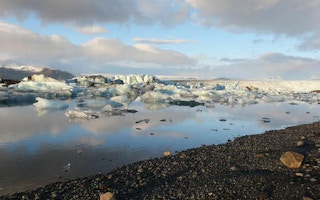The shrinking Arctic sea ice – a loss of 8% per decade during the last 30 years – isn’t just bad news for polar bears. It could be bad news for citizens of Europe and the United States who like to think they live in a temperate zone.
Qiuhong Tang of the Chinese Academy of Sciences and colleagues from Beijing and the US report in Nature Climate Change that they have identified a link between declining snow and ice in the polar north, and catastrophic heat waves, droughts and floods in the mid-latitudes.
Recent years have been marked by devastating extremes of heat in Russia, Europe and the US, and by unprecedented floods in the UK and in East Asia. Over the same period, snow cover and sea ice in the Arctic have been in retreat.
The link, the scientists say, could be changes in atmospheric circulation triggered by the loss of snow cover.
There are perfectly good reasons to expect some impact on weather systems from a retreat of the snow line. In the first place, snow and ice are white – that is, they reflect sunlight, and its warmth – while ocean and forest and tundra are dark, and absorb heat.
Closer link established
Good snow fall means lots of soil moisture in the summer months while dry ground tends to be warmer. So temperatures change, overall. Air currents flow because of pressure differences, which are linked to temperature. So winds would inevitably be affected.
But the researchers went beyond this loose generalisation, to match satellite observations of the snow cover and sea ice extent in the Arctic with atmospheric data, to explore the effects further south.
They found a distinct set of patterns of circulation associated with the loss of snow and ice.
The upper atmospheric winds in the north become weaker, and the jet stream shifts northwards, which means that weather systems become more stable. The longer a weather system stays in one location, the greater the probability that the conditions will become extreme.
In 2012, in the continental United States, it was the hottest summer ever recorded and the second worst for floods, hurricanes and droughts. In September 2012, the Arctic sea ice fell to its lowest level ever. It could be just chance, it could be just two aspects of the same big picture, but Tang and colleagues think not.
Hotter future
They think the link is clear. They even see a closer link between the loss of sea ice and a change in circulation pattern, even though the area of sea ice lost is only half of the total area of snow lost in the months of May and June.
That could be because much of the northern hemisphere snow cover is over land which is forested anyway – that is, partly dark – whereas the Arctic sea can only be white or dark.
The link is not certain – they are putting the idea out there for others to challenge or confirm, which is the way science advances – but the three authors argue that their research builds on studies by others which spell out the same conclusion.
And they don’t see things getting better, either for polar bears who need the sea ice to hunt, or for farmers in the great plains of the US or city dwellers on floodplains and river estuaries in the temperate world.
“As greenhouse gases continue to accumulate in the atmosphere and all forms of Arctic ice continue to disappear, we expect to see further increases in summer heat extremes in the major population centres across much of North America and Eurasia where billions of people will be affected”, they conclude.










